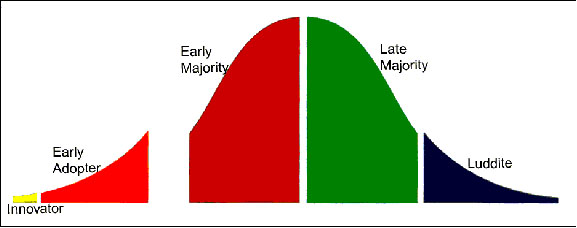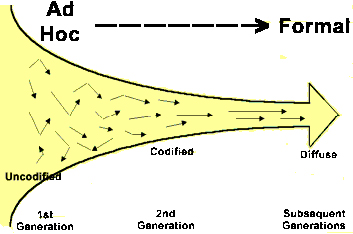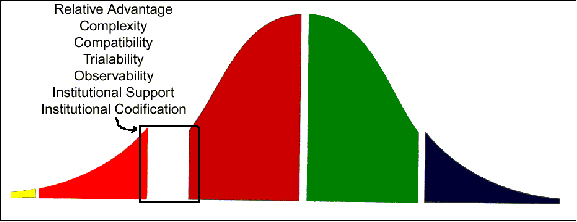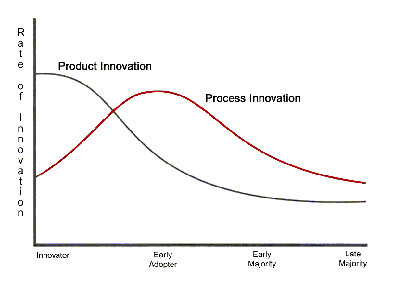
The Diffusion of Technology into the Classroom

Moore’s Technology Adoption Life Cycle (1999, p. 17) This simple bell-shape curve denotes the stages of innovation adoption. The gap between early adopter and early majority suggests an adoption barrier.
The degree of adoption of an innovation in teaching and its maturation process can be determined by its diffusion or rate of adoption. According to diffusion theorist, Everett Rogers (1995), “Diffusion is the process by which an innovation is communicated through channels over time among members of a social system” (p. 5). The social systems of any institution include its human resources management infrastructure. Rogers posits that innovations can be characterized by a classification scheme that comprises five attributes: relative advantage, compatibility, complexity, trialability, and observability. Relative advantage describes “the degree to which an innovation is perceived as being better than the idea it supersedes” (Rogers, 1995, p. 212). Relative advantage is the perception that a particular innovation will bring some improvement. The improvement may bring an economic, social, or prestigious benefit. Compatibility describes “the degree to which an innovation is perceived as consistent with existing values, past experiences, and the needs of potential adopters” (p. 224). The innovation will be perceived as being congruent or incongruent with existing institutional values and goals. Compatibility, or the lack thereof, influences the adoption rate of the innovation in question. Complexity is the relative perception of the degree of difficulty involved in adopting an innovation. The more complex the innovation is perceived to be, the slower the rate of adoption. According to Rogers, trialability is “the degree to which an innovation may be experimented with on a limited basis” (p. 243). The more a potential adopter is able to try out the innovation, the greater the likelihood of its adoption. Observability is visibility of the innovation. The more the potential adopter is able to observe the innovation, the greater the likelihood of its adoption. In addition to Rogers’ (1995) five attributes, this study added two additional attributes: institutional support and institutional codification. Institutional support is the extent to which an institution sustains and maintains innovative practices. Institutional support may include technology support in hardware and software, the granting of financial incentives, and the addition of specialized employees dedicated to the implementation of the innovation. Institutional codification is the extent to which an institution recognizes, legitimizes, and authorizes the adoption of innovative practices by codifying these practices in its official documents and thereby granting the innovation an official and permanent status.

The Sociocultural Innovation Continuum.
This continuum shows, that in the first generation of technology
adoption,
practices are uncodified and become codified as diffusion progresses.


The innovators and developers of online teaching
have defined the characteristic features of the products utilized in online
teaching. The dominant product design has emerged. Online instruction
customarily involves a system of Internet-based content delivery, predominantly
in the form of text. The dominant design for online instruction also includes
the use of e-mail for communications between students and teachers. Newsgroups
are used for virtual classroom discussions. Web-based resources are utilized as
a virtual library. For institutions with sufficient bandwidth, video-streaming
features are included. Synchronous chat rooms are possible. Class registration
and the reporting of grades are accomplished electronically. Student support
services, while not universal, are available. The emergence of the dominant
design for online instruction creates an implicit understanding of the
performance requirements to be met by the product. For instance, no one needs to
inquire whether an online class uses e-mail. It is expected that this capability
is inherent in the product design. According to Utterback (1996), a dominant
design has emerged in online enterprise solutions to online teaching. Hence few
substantive product innovations have entered the marketplace in the past 3
years.
Utterback (1996) further stipulates
that when the innovations of products reach a plateau, the innovations of
process become the major impetus. “Product innovation and process innovation are
interdependent; as the rate of product innovation decreases, it is common to
observe a growing rate of process innovation” (p. 83). Hence, few capabilities
have been added to the online teaching environment in the past 3 years because
the period of product innovation has slowed with the emergence of a dominant
design.
See also http://www.stanford.edu/class/symbsys205/Diffusion%20of%20Innovations.htm